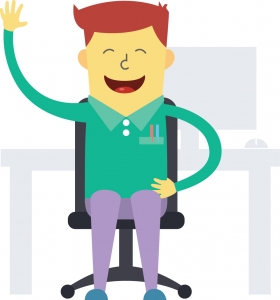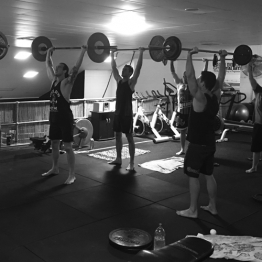Every day an increasing number of Australians experience disabling low back pain, neck pain and headaches, limiting their ability to work and engage in an active healthy life. As a member of the Chiropractors’ Association of Australia, Townsville’s Suzanne Jarschke highlights the extent of the problem and gives some tips to ‘Get your Happy Back’ during Spinal Health Week.
“Our backs were not designed to spend long periods of time sitting. We should aim to spend 20% of our day sitting, but unfortunately many of us spend the majority of the day in this position”
The Australian Government’s Institute of Health and Welfare estimates that 70-90% of Australians will experience lower back pain at some point in their lives, 10-15% will have neck pain, and 10% will experience significant disability as a result. Although back pain is common, it is often poorly managed and can be very expensive – both in terms of treatment costs and the indirect costs of disability and lost productivity.
 One explanation for this is the negative impact an increasingly sedentary lifestyle has on postural fitness. Think about all the hours you spend each day sitting at work or school, commuting, on your computer or other mobile device and watching television.
One explanation for this is the negative impact an increasingly sedentary lifestyle has on postural fitness. Think about all the hours you spend each day sitting at work or school, commuting, on your computer or other mobile device and watching television.
Also, back pain can result from injury, stress, abnormalities of the spine, degenerative changes such as arthritis, seating issues, ligament injury, incorrect lifting, lack of exercise and poor posture to name a few.
Poor posture can impact significantly on your overall health and increases pressure on your spine, causing tension, soreness, headaches, back pain and fatigue. Postural imbalances also compress your internal organs, reducing their efficiency and normal function. This may cause issues such as respiratory problems, chest tightness, high blood pressure or poor digestion.
Good posture (while standing, sitting or lying down) is the correct alignment of body parts supported by the right amount of muscle tension against gravity, allowing you to breathe better and reduce stress and fatigue.
Our backs were not designed to spend long periods of time sitting. We should aim to spend 20% of our day sitting, but unfortunately many of us spend the majority of the day in this position.
Spending six to eight hours a day in front of a computer can lead to shoulder, arm, hand and neck problems, as well as issues with balance and coordination. After headaches and colds, back pain is the third most common reason for taking time off work. Specifically, the work-related physical activities that are believed to be related to the onset of low back symptoms include lifting heavy weights, bending and twisting, and, of course, working in the same position for extended periods.
The good news is that postural issues can be corrected, and even, in some instances reversed.
How to get Your Happy Back in the office
- When in a working environment that requires a lot of desk and computer work, make sure your workstation equipment is ergonomically sound
- Consider investing in a standing workstation
- Take short, regular breaks from sitting to stretch, stand, change or correct your posture or walk around the office. Aim for one to two minutes break for every 30 minutes you spend sitting at a workstation
- Download the ‘Sit Right’ widget to remind you to take regular breaks – www.chiropractors.asn.au/sitrightapp
- Recline slightly to ease lower back pressure
- Ensure your feet are flat on the floor or on a footrest
- Keep your hips, elbows and knees at open angles (slightly more than 90 degrees).
General tips and where to start
- Get an accurate diagnosis
- Find the right practitioner to help you
- Build core strength, not endurance: Research shows that decreased core-stability is predictive of low back pain. Exercises for core stability are believed to be protective, preventative and rehabilitative for back problems. You can increase your core-stability by learning exercises that are not difficult to do and can be integrated into your daily lifestyle.
- Don’t let ‘fear avoidance behaviour’ stop you getting better: People with chronic pain often become so fearful of causing pain that they avoid doing movements or activities that you would normally do.
- Listen to your body: Nobody knows your body better than you, so the most important thing is to listen to your body. If any exercise causes or aggravates your pain, you must stop that exercise immediately.
- Prevention is better than cure: Like managing the engine of your car, you should work on your back even when you’re feeling good. A good practitioner will find problems you didn’t even know you had, which can prevent further serious problems or injuries arising.
 Chiropractic care focuses on the relationship between body structure (primarily the spine and pelvis) and function (as coordinated by the nervous system) and how this relationship can restore and maintain health.
Chiropractic care focuses on the relationship between body structure (primarily the spine and pelvis) and function (as coordinated by the nervous system) and how this relationship can restore and maintain health.
Helping people make positive changes with respect to nutrition, exercise and wellness is also fundamental to maintaining normal spinal function. Adopting healthy habits today, such as improving postural fitness, can significantly reduce the risk of injury or pain in later years, positively impacting on our self-esteem, social relationships and mental health.
Get involved
Make an appointment with your local CAA chiropractor for a spinal health check-up and discover what steps you can take to improve your health and wellbeing and Get Your Happy Back.
Find more information here www.locateachirorpactor.com.au and here www.spinalhealthweek.com.au.
The information provided is general in nature and should not substitute any health or medical advice. Please consult a qualified professional to assist with any specific conditions or queries. The opinions expressed as those of the individual columnist. You know the drill…










